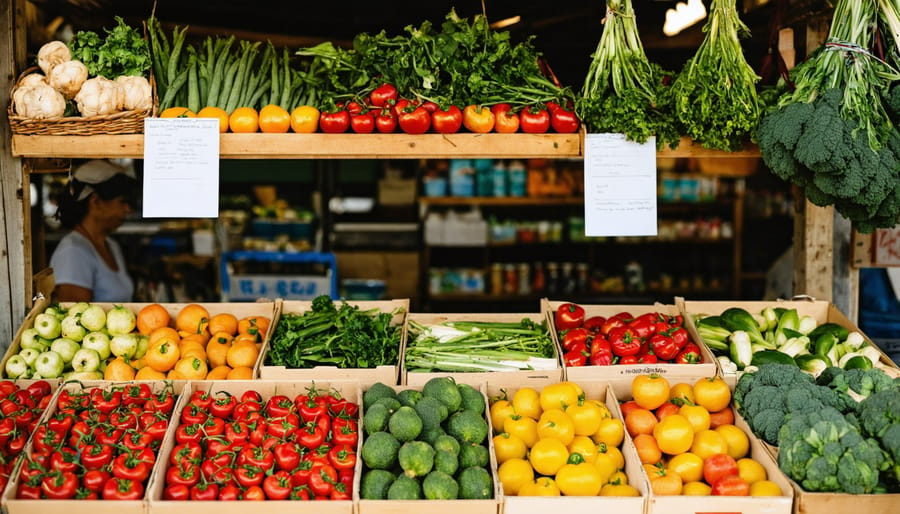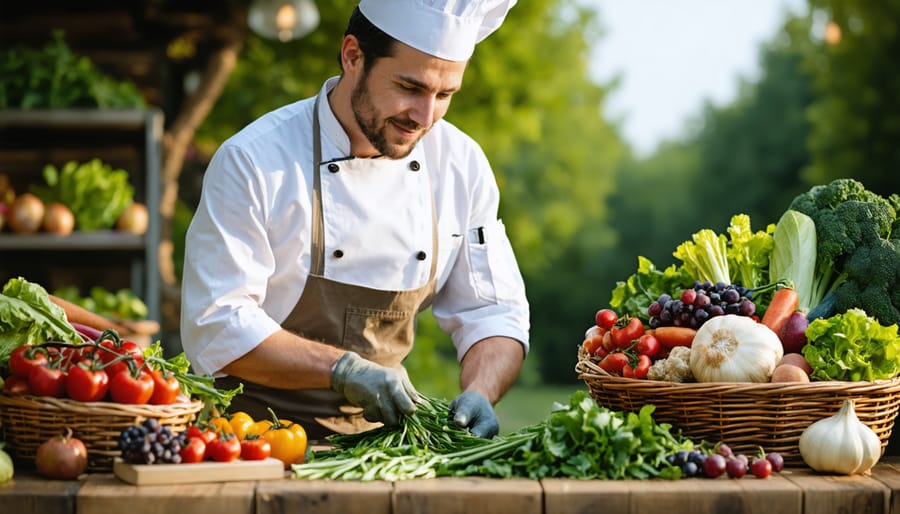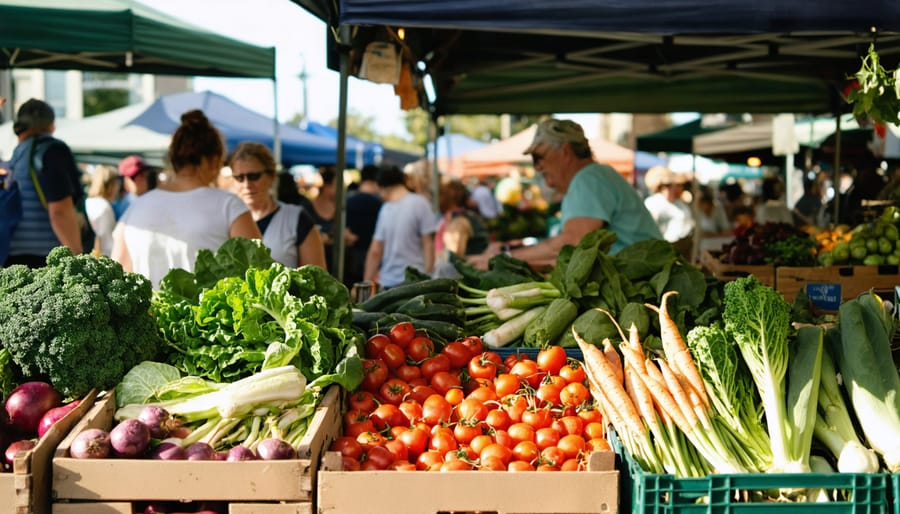The farm-to-table revolution represents a transformative shift in how we connect with our food, bringing fresh ingredients directly from local farms to our plates. This movement goes far beyond a simple food trend – it’s a complete reimagining of our food system that prioritizes freshness, sustainability, and community connections. By shortening the distance between farmers and consumers, farm-to-table creates a transparent food chain where you can trace every ingredient back to its source, often within 100 miles of your table. This direct partnership between local farmers and consumers not only ensures peak-fresh produce but also strengthens local economies, reduces environmental impact, and fosters meaningful relationships between growers and eaters. Whether you’re a home cook passionate about quality ingredients or a conscientious consumer concerned about food sustainability, understanding farm-to-table principles opens the door to more mindful, delicious, and community-centered eating.
The Real Meaning of Farm-to-Table
Beyond the Buzzword
Traditional food systems often involve multiple intermediaries, with produce traveling hundreds or even thousands of miles before reaching your plate. Farm-to-table dramatically shortens this journey, creating a direct line between farmers and consumers. Instead of produce sitting in warehouses or spending days in transit, farm-to-table vegetables often go from harvest to table within 24 hours.
This direct connection benefits everyone involved. Farmers receive fair compensation for their work and maintain control over their growing practices. Restaurants and consumers get fresher, more nutritious produce at peak ripeness. The environmental impact is also significantly reduced, with fewer transportation emissions and less packaging waste.
Consider this: A conventional tomato might change hands 5-6 times and travel over 1,500 miles before reaching your salad. In contrast, a farm-to-table tomato might travel just 30 miles from a local farm to your favorite restaurant or farmers’ market, preserving both flavor and nutritional value.
Key Components of True Farm-to-Table
True farm-to-table practices are built on several essential pillars that work together to create a sustainable and transparent food system. Direct relationships between farmers and consumers form the foundation, with farmers selling their produce directly through farmers’ markets, CSA programs, or partnerships with local restaurants. Seasonal eating is another crucial component, as authentic farm-to-table operations follow natural growing cycles rather than forcing year-round availability.
Traceability plays a vital role, with clear documentation of where food comes from and how it’s grown. This includes transparent farming practices, harvest dates, and delivery methods. Local sourcing is paramount, typically keeping food distribution within a 100-mile radius to maintain freshness and reduce transportation impacts.
Quality and freshness standards are non-negotiable, with produce often harvested within 24-48 hours of reaching the consumer. Sustainable farming practices, including organic methods, soil health management, and responsible water usage, round out the key elements that define genuine farm-to-table operations.
Building Strong Community Partnerships
Farmer-Restaurant Relationships
The heart of farm-to-table dining lies in successful farm-restaurant partnerships that bring fresh, local ingredients directly from fields to plates. These relationships often begin with chefs visiting local farms, getting to know the farmers, and understanding their growing practices. Farmers work closely with restaurants to plan seasonal menus, adjusting their crop schedules to meet culinary needs while maintaining sustainable farming practices.
Many farmers customize their growing plans based on specific restaurant requests, cultivating unique or heritage varieties that add distinctive flavors to dishes. Regular communication helps both parties coordinate harvest times with menu changes, ensuring optimal freshness and reducing food waste. Some partnerships even include restaurant staff participating in harvest days or farmers hosting educational sessions for kitchen teams.
These collaborations often extend beyond simple buying and selling. Many restaurants prominently feature their farm partners on menus and websites, while farmers gain stable income streams and valuable feedback about crop varieties. This mutual support creates a sustainable local food system that benefits both businesses while delighting diners with exceptional fresh flavors.
Community Support Networks
Community support networks form the backbone of the farm-to-table movement, creating vital connections between farmers and consumers. Farmers markets serve as vibrant weekly meeting points where locals can purchase fresh produce directly from growers while learning about seasonal offerings and farming practices. These markets not only provide access to fresh, local food but also foster meaningful relationships between producers and consumers.
Community Supported Agriculture (CSA) programs offer another powerful way to support local farmers. Members pay upfront for a season’s worth of produce, providing farmers with essential early-season capital while sharing in both the bounty and risks of farming. CSA subscribers typically receive weekly boxes of fresh, seasonal produce, often accompanied by newsletters featuring recipes and farm updates.
Food co-ops represent yet another pillar of community support, operating as member-owned grocery stores that prioritize local sourcing. These democratically run organizations often work directly with multiple local farmers, providing year-round market access while keeping prices fair for both producers and consumers. Many co-ops also offer educational programs and cooking classes, helping members make the most of seasonal produce and supporting the broader farm-to-table ecosystem.

Success Stories from the Field
Local Farm Spotlight
Green Valley Organics, nestled in the rolling hills of Vermont, exemplifies the farm-to-table movement’s success. Sarah and Mike Thompson, former tech professionals turned farmers, transformed their 15-acre plot into a thriving hub of sustainable agriculture that’s become one of our most inspiring local farm success stories.
Their operation specializes in heritage vegetables and rare fruit varieties, supplying fresh produce to five local restaurants and maintaining a 100-member CSA program. What sets Green Valley apart is their innovative approach to community engagement. They host monthly farm-to-table dinners where guests harvest ingredients for their meals, creating an immersive educational experience.
The farm’s success stems from their commitment to regenerative practices, including companion planting and natural pest management. They’ve reduced water usage by 40% through drip irrigation and collect rainwater for their greenhouse operations. Their weekly newsletter connects customers directly with their food source, sharing recipes, farming updates, and upcoming harvest schedules.
The Thompsons prove that sustainable farming isn’t just environmentally conscious – it’s economically viable. Their model demonstrates how small-scale agriculture can thrive while nurturing both community relationships and the land.


Restaurant Partnership Case Study
The Blue Hill Restaurant in New York’s Hudson Valley exemplifies a successful farm-to-table partnership that has thrived for over two decades. Working directly with Stone Barns Center for Food and Agriculture, the restaurant sources nearly 80% of its ingredients from within a 30-mile radius.
Chef Dan Barber collaborates closely with local farmers to plan seasonal menus months in advance. This partnership allows farmers to grow specific heritage varieties of vegetables and raise heritage breed livestock that perfectly match the restaurant’s culinary vision. The restaurant’s menu changes daily based on harvest schedules and seasonal availability.
The partnership extends beyond simple purchasing agreements. Blue Hill’s kitchen staff regularly visits the farm to understand growing practices and harvest timing, while farmers participate in menu planning sessions. This close collaboration has created a sustainable economic model that benefits both parties – the restaurant receives ultra-fresh, high-quality ingredients, while farmers enjoy guaranteed purchase agreements and premium prices for their produce.
This partnership has become a model for other restaurants and farms looking to establish meaningful farm-to-table relationships, demonstrating how direct collaboration can create both culinary excellence and agricultural sustainability.
Starting Your Own Farm-to-Table Initiative
Finding Local Partners
Building relationships with local farmers and food producers is easier than you might think. Start by visiting your local farmers’ markets, where you can meet producers face-to-face and learn about their growing practices. Many farmers are eager to establish direct relationships with regular customers and restaurants.
Community Supported Agriculture (CSA) programs offer another excellent way to connect with local farms. These programs typically provide regular deliveries of seasonal produce while supporting local agriculture. Food co-ops and natural food stores often maintain relationships with nearby farmers and can help facilitate connections.
Social media and online directories have made finding local producers simpler than ever. Websites like LocalHarvest and USDA’s Farmers Market Directory can help you locate nearby farms and markets. Don’t forget to check Facebook groups and Instagram accounts focused on local food in your area.
Consider attending agricultural events, farm tours, and food festivals in your region. These gatherings provide opportunities to network with farmers, learn about their operations, and discover new local food sources.
Building Sustainable Relationships
Building successful farm-to-table relationships requires dedication, clear communication, and mutual understanding between farmers and buyers. Start by visiting local farmers’ markets to meet producers and learn about their growing practices. When approaching farmers, be transparent about your needs and expectations while showing genuine interest in their work.
Regular communication is key – establish consistent ordering schedules and discuss seasonal availability well in advance. Consider signing up for CSA programs or joining local food co-ops to support farmers while gaining firsthand experience with the farm-to-table model.
Remember that successful partnerships are built on trust and flexibility. Be understanding of weather-related challenges and seasonal variations that may affect produce availability. Supporting farmers during slower seasons helps maintain strong relationships year-round. Many successful farm-to-table partnerships also include farm visits, harvest celebrations, and community events that strengthen these vital connections.
Celebrate and share your farm-to-table success stories with your community to inspire others and help grow the local food movement.
The farm-to-table movement continues to strengthen communities by fostering direct relationships between farmers and consumers. As more people recognize the value of locally sourced food, these partnerships create lasting benefits for everyone involved. Farmers receive fair compensation for their work, while consumers enjoy fresher, more nutritious produce and a deeper connection to their food sources.
Looking ahead, farm-to-table collaborations are poised to grow even stronger. Local food systems are becoming more resilient through innovative approaches like community-supported agriculture programs, farmers’ markets, and farm-to-school initiatives. These partnerships not only support sustainable agriculture but also boost local economies and promote environmental stewardship.
By participating in farm-to-table initiatives, we can all contribute to a healthier, more sustainable food system. Whether you’re a consumer making conscious food choices, a restaurant owner sourcing local ingredients, or a farmer connecting directly with your community, you’re part of a movement that’s reshaping how we think about and value our food.

